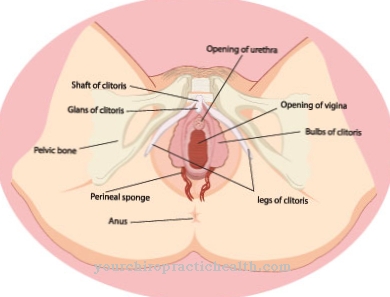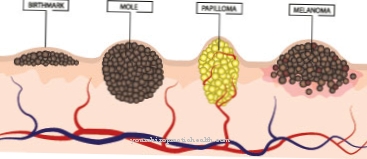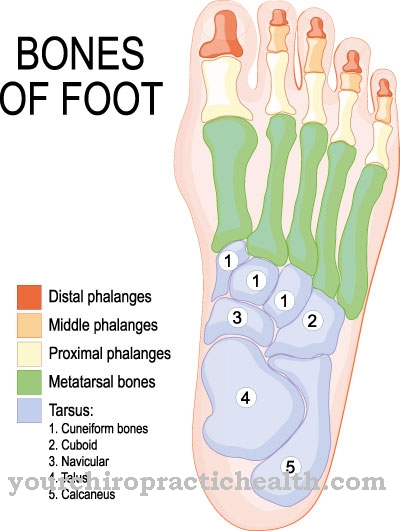The Leber optic atrophy In medicine, denotes a disease that affects the optic nerves of the eyes. It leads to the degeneration of the fibers and thus to massive impairment of vision up to blindness.
What is Leber's Optic Atrophy?

© georgerudy - stock.adobe.com
In the Leber optic atrophy it is a rare hereditary disease that affects eye health. Despite its slightly misleading name, the disease has nothing to do with the organ liver: The name comes from its discoverer, the ophthalmologist Theodor Carl Gustav von Leber. It affects the optic nerve (Nervus opticus) and is of genetic origin.
With a frequency of 1 in 50,000 to 1 in 100,000, Leber's optic atrophy is rare in the general population. It mainly affects men who fall ill between the ages of 15 and 35. The disease rarely breaks out in childhood. There is currently no established therapeutic method for Leber's optic atrophy. That is why the disease reduces the eyesight to two to five percent in almost all those affected. In medicine, Leber's optic atrophy is one of the mitochondriopathies. These are a group of diseases that are caused by the mitochondria of the body's own cells.
causes
Leber's optic atrophy is passed on from one generation to the next from women. Medicine calls this form of inheritance maternal (maternal) heritability. However, Leber's optic atrophy breaks out much less often in women. A point mutation in the mitochondrial gene sequence is responsible. Mitochondria are special organelles that can be found in every animal cell.
Biology also calls them the “power plants of the cell”, because they are indispensable for the cellular respiration of animal (and therefore also human) cells. During this biochemical process, the mtochondria form chemically bound energy (ATP), which the cell can use directly. From a genetic point of view, mitochondria are distinguished from other components of cells by a special feature: they have their own genetic information, while the DNA in the cell nucleus stores the genes of other organelles.
According to the endosymbiotic hypothesis, at an early stage of evolution, in the unicellular stage, mitochondria were still independent mini-organisms. As a result of symbiosis with other cells, they may be absorbed into the larger single-cell organisms, which means that they benefit significantly from the host's metabolism. As a result, according to the theory, they survived evolutionary selection and can only be found today as organelles.
However, the mitochondria owe this development to the fact that their genes do not belong to the cell nucleus DNA, but rather form their own nucleic chains in the mitochondria. In Leber optic atrophy, the mutation occurs in this mitochondrial gene sequence. It concerns items 3460, 11778 and 14484. Since only the mothers pass on their mitochondria to the children, men are not considered to be carriers of this hereditary disease.
Symptoms, ailments & signs
Those affected may notice Leber's optic atrophy at an early stage due to the impairment of color perception: At the beginning, they are less able to differentiate between red and green. In the advanced stage, Leber's optic atrophy also means that the patient can no longer see clearly in the visual center. Often those affected unconsciously try to compensate for this weakness by looking past the actual object of their interest.
As a result, the eye no longer sees that object with the nerves of the visual center, but with the peripheral sensory cells. Since Leber's optic atrophy does not yet affect the peripheral areas of vision at this point in time, patients can at least partially compensate for the restriction by seeing past them.
It is also typical for Leber's optic atrophy to initially only affect one eye before the symptoms spread to the second eye after a while. There can be a period of up to nine months in between. However, the symptoms in the second eye can manifest themselves after a few days. Furthermore, visual field defects (scotomas) are a potential sign of Leber's optic atrophy.
Diagnosis & course of disease
The symptoms described above justify a suspicion of Leber's optic atrophy; An examination of the optic nerve is required for diagnostic clarification. An optical procedure can make the background of the eye visible and thus provide more precise information about its condition. Doctors not only have to differentiate between the cause of the complaints; The differentiation of Leber's optic atrophy from other forms of optic atrophy is also important.
Since the disease can usually not be treated successfully today, those affected must expect a drastic reduction in their eyesight. Often only two to five percent of the original ability to see is retained.
Complications
With this disease, those affected primarily suffer from eye discomfort. These can express themselves very differently. As a rule, at the onset of the disease there is a red-green weakness, so that those affected are significantly restricted in their everyday life. The disease also leads to a significant reduction in visual acuity, so that patients are usually dependent on glasses or contact lenses.
In the worst case, the disease can also lead to complete blindness of the patient, which is also associated with considerable restrictions in everyday life. The disease also spreads to the other eye and leads to these complaints there too. Treatment of blindness is not possible. It is not uncommon for failures in the visual field and further disorders of sensitivity to occur.
Treatment of this condition is carried out with the help of drugs. This does not lead to complications, but the complaints can usually not be completely limited. However, the disease does not affect the patient's life expectancy, so it does not decrease.
When should you go to the doctor?
If your eyesight is impaired, you should see a doctor as soon as possible. Changes in eyesight are considered unusual and must always be checked medically. If your vision is blurred and people or objects are no longer recognized as usual, it is advisable to consult a doctor. There is cause for concern if spatial vision is impaired. A doctor should be consulted so that there is no severe or sudden deterioration. If the eyesight is reduced in direct comparison to other people, a check-up should be arranged.
If the eyesight continues to decrease, the cause of the symptoms must be clarified so that treatment can be initiated in good time. If the colors red and green cannot be clearly distinguished from one another, the person affected should discuss the observations with my doctor. If the patient notices that he is increasingly looking past the targeted objects in order to see its contours more clearly, a doctor's visit is necessary. If the eyesight is different in both eyes, this should be examined more closely and tested by a doctor. If you experience a headache, dizziness or a feeling of pressure in the head, a medical consultation is advisable. If you have a vague feeling of illness, pain in the eyes or eye socket or if there is an increased risk of accidents, a doctor should be consulted.
Therapy & Treatment
Apart from a few experimental therapeutic approaches, no effective treatment for Leber's optic atrophy is known. However, doctors are hoping for the first results from not using hydrogen cyanide. Hydrocyanic acid is presumably related to the outbreak of Leber's optic atrophy; However, this treatment method does not guarantee success and ideally only supports a positive development of the disease.
Hydrocyanic acid is found in alcohol, tobacco, nuts and cabbage, for example. Since 2015, the pharmaceutical trade has also been selling the first drug with the active ingredient Idebenone. Researchers originally developed this drug to treat cognitive impairments such as those found in Alzheimer's dementia.
You can find your medication here
➔ Medicines for visual disturbances and eye complaintsOutlook & forecast
The prognosis for the disease is poor. Liver optic atrophy is a genetic disease. Since, for legal reasons, researchers and scientists are not allowed to modify human genetics, only symptomatic treatment measures can be taken. These are very difficult with this health disorder. Since the disease leads to a weakening of the eyesight, the burden for the person concerned is very high in everyday life. This leads to impairments, an increased risk of accidents and increased risks of secondary diseases. Often mental disorders are documented in the further course. These must be taken into account in the overall forecast.
At an advanced stage, eyesight is so reduced that it is no longer possible to fulfill daily obligations without the help of other people. In addition, facial deficits occur, which lead to a further deterioration in quality of life. A visual flaw is perceived, which can also become an emotional burden for the person concerned. The joy of life and participation in social and societal life often decline.
If the disease progresses very poorly, both eyes become blind. In order to improve their own health, the person concerned should pay sufficient attention to emotional well-being. While there will be no healing, learning to deal with the disorder should be learned.
prevention
The prevention of Leber optic atrophy is not possible because it is a hereditary disease. External influences only play a subordinate role - if at all. The above-mentioned measures, such as avoiding foodstuffs and luxury foods containing hydric acid, can possibly delay an outbreak or promote a milder course at an early stage.
Aftercare
As a rule, there are few follow-up measures available to those affected by this disease, as it cannot be completely cured. If the person concerned has become completely blind, follow-up care can no longer be carried out, as this is usually not necessary. The disease itself can in some cases be treated with the help of medication.
The affected person must ensure regular use and the correct dosage to alleviate the discomfort in the eyes. Likewise, a healthy lifestyle with a healthy diet can have a very positive effect on the further course of the disease and slow down the progression of the disease. Above all, the patient should avoid tobacco and alcohol.
Since the disease often occurs together with dementia, many of those affected depend on the help and support of their own families in their everyday lives. Loving and intensive conversations also have a positive effect on the further course of the disease and can also prevent depression or mental disorders. In most cases, the disease does not reduce the person's life expectancy.
You can do that yourself
Patients with Leber's optic atrophy experience increasing impairment of their vision and thus their quality of life as a result of the disease. Since the disease first affects the perception of colors negatively, this is an important symptom for early detection and those affected contact an ophthalmologist immediately. Patients take the medication prescribed by a doctor as instructed and seek medical advice immediately if any side effects occur.
As the disease usually progresses, patients come to terms with the increasing impairment of their visual function. The blurred vision can only be compensated to a certain extent with visual aids such as glasses. It is most important that those affected accept the disease and still try to achieve a comparatively high quality of life. For example, it is helpful to make contact with other visually impaired people in order to receive social support.
Medical experience so far indicates a negative influence of hydrogen cyanide on the outbreak and course of the disease. Therefore, patients strictly refrain from consuming alcohol or tobacco.In some cases the disease ultimately leads to blindness, so that the patients adapt their living space to the changed circumstances and learn to orientate themselves with a long stick.


.jpg)



.jpg)






.jpg)

.jpg)
.jpg)











.jpg)